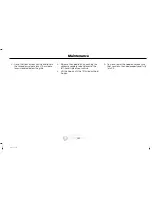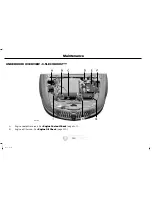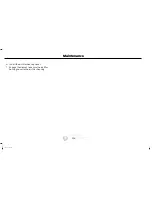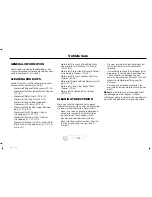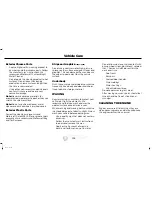
At this time, you may notice your engine
coolant temperature gauge needle move
toward the
H
and the
POWER REDUCED
TO LOWER TEMP
message may appear in
the information display.
You may notice a reduction in vehicle speed
caused by reduced engine power. In order to
manage the engine fluid temperatures, your
vehicle may enter this mode if certain
high-temperature and high-load conditions
take place. The amount of speed reduction
depends on many factors such as vehicle
loading, towing, grade and ambient
temperature. If this occurs, there is no need
to pull off the road. You can continue to drive
your vehicle while this message is active.
The air conditioning may also cycle on and
off during severe operating conditions to
protect overheating of the engine. When the
engine coolant temperature decreases to a
normal operating temperature, the air
conditioning will turn on once again.
If the engine coolant temperature gauge
moves fully into the red (hot) area, or if the
coolant temperature warning or service
engine soon messages appear in your
information display:
1.
Pull off the road as soon as safely
possible and shift the transmission into
P
.
2. Leave the engine running until the coolant
temperature gauge needle moves away
from the red (hot) area. After several
minutes, if the temperature does not
drop, follow the remaining steps.
3. Switch the engine off and wait for it to
cool before checking the coolant level.
4. If the coolant level is normal, restart your
engine and continue.
5. If the coolant is low, add coolant, and
restart the engine. See
Adding Engine
Coolant
or
How Fail-Safe Cooling
Works
in this chapter for more
information.
AUTOMATIC TRANSMISSION
FLUID CHECK
6F50/6F55 Transmission
(If Equipped)
WARNINGS
The dipstick cap and surrounding
components may be hot, use gloves.
Use gloves when moving the air filter
assembly. Components will be hot.
Note:
Automatic transmission fluid expands
when warmed. To obtain an accurate fluid
check, drive your vehicle until you warm it up,
approximately 20 mi (30 km). If you operate
your vehicle for an extended period at high
speeds, in city traffic during hot weather or
pulling a trailer, switch your vehicle off until it
reaches normal operating temperatures to
allow the fluid to cool before checking.
Depending on vehicle use, cooling times could
take up to 30 minutes or longer.
Refer to your scheduled maintenance
information for scheduled intervals for fluid
checks and changes. Your transmission does
not consume fluid. However, you should
check the fluid level if the transmission is not
working properly. For example, if the
transmission slips or shifts slowly or if you
notice some sign of a fluid leak.
1.
Drive your vehicle 20 mi (30 km) or until
it reaches normal operating temperature.
2. Park your vehicle on a level surface and
engage the parking brake.
3. With the parking brake engaged and your
foot on the brake pedal, start the engine
and move the gearshift lever through all
of the gear ranges. Allow a minimum of
10 seconds for each gear to engage.
4. Put the gearshift lever in park (P) and
leave the engine running.
244
MKS (), enUSA
Maintenance
Summary of Contents for 2015 MKS
Page 3: ...I n f o r ma t i o nP r o v i d e db y ...
Page 9: ...6 MKS enUSA I n f o r ma t i o nP r o v i d e db y ...
Page 115: ...E138647 112 MKS enUSA Seats I n f o r ma t i o nP r o v i d e db y ...
Page 195: ...Example only E142523 192 MKS enUSA Load Carrying I n f o r ma t i o nP r o v i d e db y ...
Page 301: ...E142732 298 MKS enUSA Capacities and Specifications I n f o r ma t i o nP r o v i d e db y ...






